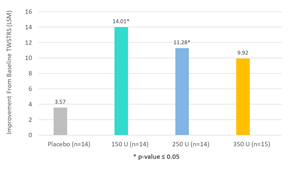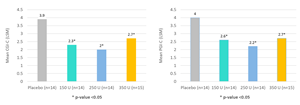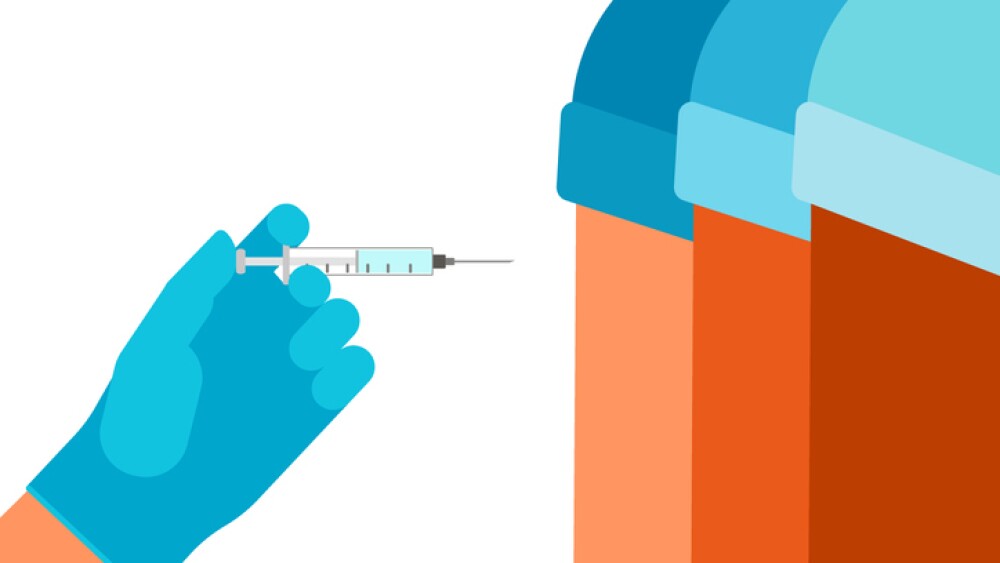AEON Biopharma, Inc. today announced positive topline results from its Phase 2 clinical study of ABP-450 for the treatment of cervical dystonia (CD), a chronic and debilitating neurologic condition affecting the muscles of the neck.
– Phase 2 trial met primary and secondary endpoints with statistical significance in reducing signs and symptoms associated with cervical dystonia (CD) in adults –
– All three dosing arms demonstrated a median duration of effect greater than or equal to 20 weeks, the last point at which patients were evaluated –
– End-of-Phase 2 meeting with FDA expected in Q1 2023, and plan to initiate Phase 3 program for CD in 2023 –
– Phase 2 program with ABP-450 in prevention of both chronic and episodic migraine is actively enrolling with topline data for episodic migraine anticipated in fall 2023 –
IRVINE, Calif., Sept. 23, 2022 (GLOBE NEWSWIRE) -- AEON Biopharma, Inc. (“AEON” or the “Company”), a private clinical-stage biopharmaceutical company focused on the development of its proprietary botulinum toxin complex ABP-450 (prabotulinumtoxinA) injection for therapeutic indications, today announced positive topline results from its Phase 2 clinical study of ABP-450 for the treatment of cervical dystonia (CD), a chronic and debilitating neurologic condition affecting the muscles of the neck.
“We’re pleased to announce the topline data from the Phase 2 study of ABP-450, as we continue to develop prabotulinumtoxinA injection for treatment of debilitating medical conditions, including cervical dystonia. These overwhelmingly positive data confirms that ABP-450 has a therapeutic profile that is consistent with or exceeds that of other botulinum toxin products and gives us renewed confidence in our other indications for migraine prevention and treatment of gastroparesis. We look forward to starting Phase 3 in CD and announcing Phase 2 data in episodic migraine in 2023,” said Marc Forth, AEON’s President and Chief Executive Officer.
The Phase 2 randomized, double-blind, placebo-controlled study analyzed a total of 57 patients across a total of 20 study sites in the United States. Patients were divided evenly across four cohorts, including a low dose (150 units), mid-dose (250 units) and high dose (350 units) treatment of ABP-450, and placebo. Each patient received a single treatment cycle of their designated dose of ABP-450 or placebo. Patients were followed up to a total of 20 weeks, and the primary efficacy endpoint was assessed at four weeks after dosing. Due to the nature of the disease, dosing is tailored to the individual patient by the investigator based on the severity of the patient’s head and neck position, localization of pain, muscle hypertrophy, patient response, and adverse event history.
The study met its primary safety endpoint with all three doses of ABP-450 appearing to be generally safe and well tolerated with adverse event rates similar to, or lower than, other botulinum toxin products for the treatment of cervical dystonia. All treatment-related adverse events were mild or moderate in severity and transient in nature, with no serious adverse events. Each of the three active arms demonstrated low rates of dysphagia (0.0%, 12.5%, and 20.0%) and muscle weakness (14.3%, 0.0%, and 6.7%), which are common toxin-related adverse events in CD patients.
| Placebo | 150 Units | 250 Units | 350 Units | |
| Number of Patients | 14 | 14 | 16 | 15 |
| n, % | n, % | n, % | n, % | |
| Patients With TEAE | 9 (64.3%) | 8 (57.1%) | 12 (75%) | 11 (73.3%) |
| Patients With SAE^ | 0 | 0 | 0 | 0 |
| Patients With Treatment- Related TEAEs* | 2 (14.3%) | 3 (21.4%) | 8 (50%) | 5 (33.3%) |
| Dysphagia# | 0 | 0 | 2 (12.5%) | 3 (20%) |
| Muscular Weakness | 0 | 2 (14.3%) | 0 | 1 (6.7%) |
| Headache | 0 | 0 | 1 (6.3%) | 1 (6.7%) |
| Neck pain | 1 ( 7.1%) | 0 | 1 ( 6.3%) | 0 |
| Injection site pain | 1 ( 7.1%) | 1 ( 7.1%) | 0 | 0 |
^ SAE - Serious adverse event.
* All treatment-related TEAEs (treatment emergent adverse events) were either mild or moderate in severity.
# All dysphagia cases were mild.
NOTE: Other singular TEAEs, all of which were mild, included joint swelling, torticollis, nausea, dizziness, head discomfort, presyncope, feeling abnormal, injection site pruritus, malaise, diplopia and rash macular.
The main efficacy endpoint assessed the change at week four from baseline in the Toronto Western Spasmodic Torticollis Rating Scale (TWSTRS) Total Score, the gold standard in cervical dystonia trials. All three doses demonstrated a clinically meaningful improvement in the signs and symptoms of cervical dystonia, with peak efficacy occurring at week four. Subjects treated with the low and mid doses of ABP-450 showed a statistically significant improvement from baseline at week four, compared with placebo, while the highest dose narrowly missed statistical significance. The mean improvement from baseline in TWSTRS was 3.57 for placebo, 14.01 for 150 U (p=0.007), 11.28 for 250 U (p=0.0406), and 9.92 for 350 U (p=0.0864), which compares favorably to clinical trials of other botulinum toxin products.
Primary Efficacy Endpoint: Mean Improvement from Baseline TWSTRS–Total Score at Week 4
Caption: All three doses demonstrated a clinically meaningful improvement in the signs and symptoms of cervical dystonia, with peak efficacy occurring at week four.
| Placebo | 150 Units | 250 Units | 350 Units | |
| Number of Patients | 14 | 14 | 14 | 15 |
| Mean Improvement from Baseline in TWSTRS Total Score | 3.57 | 14.01 | 11.28 | 9.92 |
| p-value Difference from Placebo | 0.007 | 0.0406 | 0.0864 | |
Among the key secondary efficacy endpoints, the Clinicians Global Impression of Change (CGI-C) was highly statistically significant at all three dose levels, as was the Patients Global Impression of Change (PGI-C).
Secondary Efficacy Endpoint: Mean Clinical & Patient Global Impression of Change at Week 4 (CGI-C & PGI-C)
Caption:CGI-C reflects the physician’s perception of the patient’s health status by rating the patient on a 7-point scale from “very much improved” (a score of 1) to “very much worse” (a score of 7). Similarly, PGI-C enables the patient to rate their changes on the same scale. The Clinicians Global Impression of Change (CGI-C) was highly statistically significant at all three dose levels, as was the Patients Global Impression of Change (PGI-C).
| Placebo | 150 Units | 250 Units | 350 Units | |
| Number of Patients | 14 | 14 | 14 | 15 |
| Mean CGI-C Score | 3.9 | 2.3 | 2.0 | 2.7 |
| p-value Difference from Placebo | 0.001 | 0.0001 | 0.0095 | |
| Mean PGI-C Score | 4.0 | 2.6 | 2.2 | 2.7 |
| p-value Difference from Placebo | 0.0017 | <0.0001 | 0.0028 | |
The durability of clinical effect was assessed by measuring the time to loss of greater than or equal to 80% of the peak treatment effect on the TWSTRS total score. The median duration of effect was greater than 20 weeks for the 150 U arm, 20 weeks for the 250 U arm, and 20 weeks for the 350 U arm.
At the completion of the Phase 2 clinical study, all patients, irrespective of treatment group, had the option to receive treatment with ABP-450 by rolling over into a 52-week open-label extension study, and 51 of the 57 patients (89%) opted to do so.
About ABP-450 (prabotulinumtoxinA) Injection
ABP-450 contains a 900 kDa botulinum toxin type-A complex produced by the bacterium Clostridium botulinum. The active part of the botulinum toxin is the 150 kDa component, and the remaining 750 kDa of the complex is made up of accessory proteins that the Company believes help with the function of the active portion of the botulinum toxin. When injected at therapeutic levels, ABP-450 blocks peripheral acetylcholine release at presynaptic cholinergic nerve terminals by cleaving SNAP-25, a protein integral to the successful docking and release of acetylcholine from vesicles situated within the nerve endings leading to denervation and relaxation of the muscle. AEON licenses ABP-450 from Daewoong Pharmaceutical Co., which provides AEON exclusive development and distribution rights for therapeutic indications in certain territories, including the United States, Canada and the EU, among other international territories.
About AEON Biopharma
AEON is a clinical stage biopharmaceutical company focused on developing ABP-450 (prabotulinumtoxinA) injection for the treatment of debilitating medical conditions with an initial focus on the neurology and gastroenterology markets. The Company is dedicated to innovation in the rapidly expanding therapeutic botulinum toxin market and believes its therapeutic-only focus will allow AEON to advance safe and effective treatment options to patients, while delivering differentiated economics to payors and physicians. The Company continues to evaluate additional therapeutic indications for development based on a comprehensive product assessment process designed to identify those indications where it believes ABP-450 can attain clinical, regulatory, and commercial success. More information about AEON can be found at www.aeonbiopharma.com.
Forward-Looking Statements
This press release contains forward-looking statements that are based on management’s belief and assumptions and on information currently available to management. Forward-looking statements are subject to known and unknown risks, uncertainties and other factors that may cause the actual results, performance or achievements of the Company or its industry to be materially different from those expressed or implied by any forward-looking statements. In some cases, forward-looking statements can be identified by terminology such as “may,” “will,” “could,” “would,” “should,” “expect,” “plan,” “anticipate,” “intend,” “believe,” “estimate,” “predict,” “potential” or other comparable terminology. All statements other than statements of historical fact could be deemed forward-looking, including any statements about current or planned clinical trials or related milestones; any projections of financial information; any statements about historical results that may suggest trends for the Company’s business; any statements of the plans, strategies, and objectives of management for future operations; any statements of expectation or belief regarding future events, potential markets or market size, or technology developments; and any statements of assumptions underlying any of the items mentioned. The Company has based these forward-looking statements on its current expectations, assumptions, estimates and projections. While the Company believes these expectations, assumptions, estimates, and projections are reasonable, such forward-looking statements are only predictions and involve known and unknown risks and uncertainties, many of which are beyond the Company’s control. These and other important factors may cause actual results, performance, or achievements to differ materially from those expressed or implied by these forward-looking statements. The forward-looking statements in this press release are made only as of the date hereof. Except as required by law, the Company assumes no obligation and does not intend to update these forward-looking statements or to conform these statements to actual results or to changes in the Company’s expectations.
AEON Contacts:
Company Contact:
Alex Wilson, AEON Biopharma
General Counsel & Secretary
investor.relations@aeonbiopharma.com
Investor Contact:
Corey Davis, Ph.D.
LifeSci Advisors
+1 212 915 2577
cdavis@lifesciadvisors.com
Photos accompanying this announcement are available at
https://www.globenewswire.com/NewsRoom/AttachmentNg/7ed24873-0c11-47d2-8e66-9a3566cb6dd8
https://www.globenewswire.com/NewsRoom/AttachmentNg/9eeed622-77a4-446b-9ce9-e390ae6c8b48

Primary Efficacy Endpoint: Mean Improvement from Baseline TWSTRS–Total Score at Week 4
All three doses demonstrated a clinically meaningful improvement in the signs and symptoms of cervical dystonia, with peak efficacy occurring at week four.
Secondary Efficacy Endpoint: Mean Clinical & Patient Global Impression of Change at Week 4 (CGI-C & PGI-C)






